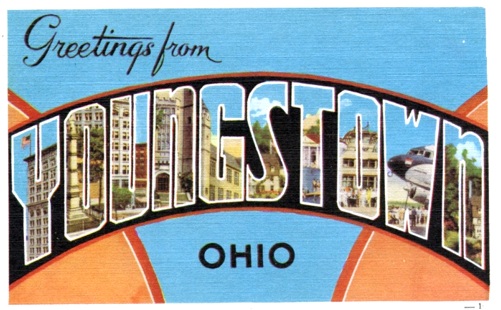Youngstown – shaking off the rust
Alan’s TTIM Stories #79
Youngstown is on the rise through innovation, tenacity, revitalization, and Penguin Pride.*
A modest town in northeast Ohio, halfway between Cleveland and Pittsburgh, Youngstown became the poster child for the rust belt. The town grew on an enormous diet of steel.
Effects of the Industrial Revolution of the late 1880’s included “skies glowed red at night from iron oxide.” The air was filled with particulate matter from open-hearth ovens. Slag left from blast furnaces were deposed with a disregard to environmental factors. Tons of carbon dioxide, sulfur dioxide, and nitrogen oxides filled the atmosphere. Water discharged from the intensive process for cooling, cleaning, and processing affected aquatic life and local water supplies.
A rapid decline of the steel industry happened in the 1970’s. Started with the depletion of local iron ore and coal. It was easier to deliver coal to the Great Lakes ports of Buffalo, Cleveland, Detroit, and Chicago. Residents consider September 19, 1977, Black Monday when Sheet and Tube closed. U.S. Steel left in 1980. The high point of population in Youngstown was 1950 with 168,330. Since the 50’s, the population plummeted to 59,123 in a 2024 estimate.
The citizens did not surrender. Remaining assets include an active arts culture, Youngstown State University, and the seat of government for Mahoning County. Plus, revitalization projects are sprouting up all over the city.
One specific project of hope is the Creek Corridor revitalization. The plan addresses reimagining industrial areas, undoing decades of environmental degradation, and correcting the lack of planning. The consultant firm, AECOM, created the Crab Creek Corridor Study to:
“1. Develop the plan in the best interests of the citizens and businesses of Youngstown
2. Define and separate the industrial and residential zones
3. Improve infrastructure serving the Crab Creek District”
The Study emphasizes redevelopment with greenspace and park components, outdoor activities, with community recreation facilities; roadway redesign with additional street lighting, traffic cameras, and street repairs; the addition of green industries and new retail establishments; green buffers between industry and residential areas; workforce development; and access to fresh produce.
The disappearance of the steel industry opened areas for a revival of industry with the addition of light industry, transportation, with environmental regulations not in place in 19th century and 20th century. Empty buildings have the potential for “light manufacturing, assembly, wholesale, and service-oriented business.”
The environment is taken into consideration. In the industrial development period, Crab Creek was reduced to a concrete ditch with consequences of a loss of habitat, the rush of stormwater creating downstream flooding, heated runoff from impervious surfaces, overall poor water quality. Restoration of a natural flow and creek bed brings back aquatic life, adds to the ground water supply, and creates a green buffer between land uses.
The Study includes roadway design. Redesigned road networks open opportunities to change land use to encourage economic growth and added green spaces. Less pavement has environmental and economic benefits. As a positive economic factor, less pavement reduces maintenance costs. Added green space supplies oxygen as opposed to the carbon dioxide of vehicular traffic. Less impervious surfaces produce less contaminated stormwater runoff and less flooding. The Study recommends a redesign of the Madison Avenue Expressway and other corridor roadways for better access to neighborhoods.
Implementing the right design develops compatible uses for industry, commercial, green areas, and residential areas allowing for prosperity, health, and civic pride. Gathering momentum and resources for change, as expressed in the Crab Creek Corridor Study, will have positive benefits for a rust belt community. The story of the Phoenix is an example, more than a myth. People of Youngstown – stand tall. Show the rest of the world how to thrive despite adversity.
Sources:
wkbn.com
Youngstown 2030
Crab Creek Corridor Study
Daily Buzz
Metro Monthly
Demac Steel (com)
Wikipedia
Photo credit: Steve Shook, Creative Commons Attribution 2.0 Generic
Penguin Pride* – mascot of Youngtown State University

Leave a Reply